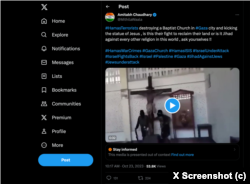X Users Falsely Claim Video of 2017 Attack on Philippines Church Shows Hamas Attack in Gaza
Blued-checked users with an active subscription to X Premium continue to use the social media platform to spread disinformation about the Israel-Hamas conflict.
Their tactics include recycling old footage and misattributing it either to the Israeli armed forces or to Hamas and Palestinians, depending on loyalties. A viral video of a 2017 church attack in the Philippines is one such example.
More than 300 people died in the fight between the Philippines security forces and Maute militants affiliated with the Islamic State terrorist group, who seized the southern city of Marawi in May 2017.
A blue-checked X user with the handle MithilaWaala shared a clip of Maute gunmen attacking the church in Marawi with the following false commentary:
“#HamasTerrorists destroying a Baptist Church in #Gaza city and kicking the statue of Jesus, is this their fight to reclaim their land or is it Jihad against every other religion in this world, ask yourselves !!”
Others shared the same footage with a similar message.
Another X user claimed the footage showed Israeli Defense Forces desecrating a church in Gaza.
Kanthan2030, a verified X user with 110.1k followers who regularly spreads pro-Russia disinformation, quoted another post with the same footage, falsely claiming it showed an attack by Syrian rebels:
“Ignorance in US/EU is shocking. Terrorists in the video below were the ‘moderate rebels’ armed, trained & funded by US/NATO. These jihadists were used to attack Syrian President Assad, who is loved by Christians in Syria. So, don’t use this video to justify bombing of Gaza.”
Kanthan2030 quoted RadioGenoa, a blue-checked user with over 292k followers. RadioGenoa simply wrote: “They hate us.”
That post received 7 million views and 30K likes.
While RadioGenoa never claimed the footage was from Gaza, a community note clarified that the footage actually showed an Islamic State affiliate destroying a church during the 2017 Siege of Marawi in the Philippines province of Lanao del Sur.
The clip shared by MithilaWaala did not include a community note, but rather a message with a hyperlink from X that reads: “Stay informed. This media is presented out of context. Find out more.”
However, the hyperlink outlines X’s synthetic and manipulated media policy, while no further context for the footage posted by MithilaWaala is provided.
X says that under its policy, it can remove “media that is shared in a deceptive manner or with false context” which can result in “widespread confusion on public issues, impact public safety, or cause serious harm.”
But MithilaWaala’s post was not removed, despite posting footage in a deceptive manner with false context.
These attempts by premium X subscribers to pass off old footage as Israel-Hamas war footage fit into a broader disinformation pattern.
A recent study by NewsGuard, an information analysis company, found that blue-checked, “verified” X users had accounted for 74 percent of the platform’s most viral false or unsubstantiated claims during the first week of the Israel-Hamas War, which started on October 7.
Polygraph.info has documented other such examples here and here.
NewsGuard said that community notes “fail to debunk misinformation almost 70 percent of the time.”
Subscribers to X Premium have a financial incentive to spread posts that go viral, including disinformation. That’s because blue-checked users are eligible for ad revenue sharing if they have 500 followers and have generated five million impressions in the preceding three months.
Separately, a European Commission report found that the engagement of pro-Kremlin accounts spreading disinformation on X, particularly about Ukraine, had grown by 36 percent “after CEO Elon Musk decided to lift mitigation measures on Kremlin-backed accounts.”
In September, European Commission Vice President Vera Jourova called X “the platform with the largest ratio of mis- or disinformation posts.”
This article has been archived for your research. The original version from Polygraph.info can be found here.




